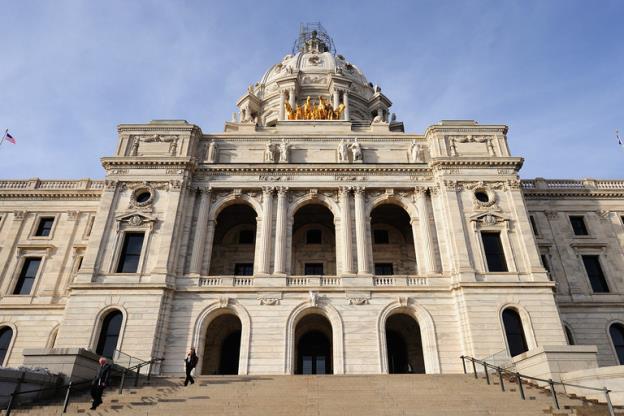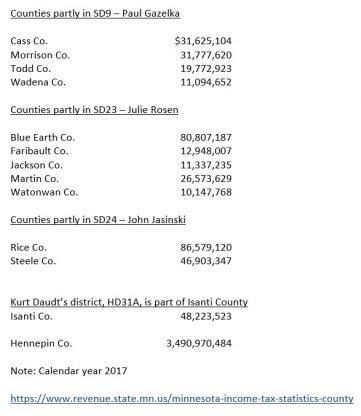
Parsimonious twittery in the Minnesota Senate (and House) – Part Two
Yesterday, I wrote a story about the relative sales and use tax contributions to Minnesota’s general fund by various counties in Minnesota represented by whining members of the Minnesota Senate (with the added bon bon of Kurt Daudt from the House) and compared them to the the contribution of Hennepin County for the same year, 2018, the last figures available.
To recap, these Minnesota senators are whining about the prospect of spending $150 million from the general fund to help Minneapolis recover from the riots last summer. Their constituents feel put upon, they say. And I said it was just parsimonious twittery.
I started with sales and use taxes, because I’ve written about them before, but now I want to turn to Minnesota income taxes. Here’s a chart of income tax collections in the counties that are in part of three Senate districts: those of Paul Gazelka, John Jasinski, and Julie Rosen. Here is where I got the information for the chart. This is 2017 data, the last available.

2017 – Selected county income tax collections
It bears repeating that Gazelka, Jasinski, and Rosen (and Daudt on the House side) do not represent all of the people who live in these counties, but we’ll give them everybody just to see how close they come to getting their chins up to the bar.
The answer is: not terribly close. The four counties that I collect under Sen. Gazelka’s wing, for example, contribute about 2.7% of what Hennepin County does. But according to him, and to Jasinski and Rosen, and Kurt Daudt in the Other Body, too, Hennepin County is the supplicant who needs to be turned away.
Hennepin County and Minneapolis have subsidized these people for a long time.
Literature is filled with stories of how wretched, ungrateful people finally get their comeuppance. I’ll let you pick your favorite.
Although it will never happen, it’d be great if our quartet of whiners, just once, would reply to a constituent email or phone call by saying, You know Hjalmer, I hear you, but you know your little town got a new sewer system courtesy of Hennepin County, and maybe we ought to help it out here.
– o O o –
Update 2/2/21: It is reported today that in a House Public Safety and Criminal Justice Reform Committee discussing appropriating money for security around the trial of the former police officers involved in the killing of George Floyd, one House member said:
“It’s basically taking funds from greater Minnesota to push them down to the metro area where the Minneapolis Police Department is not doing its duties,” said Rep. Brian Johnson, R-Cambridge.
Brian Bakst’s Minnesota Public Radio story on its website immediately corrected the wayward Johnson. The story reports that the measure passed on a party-line vote, which probably means every Republican on the committee must have thought Johnson was right.
Rep. Johnson’s district is 32A, which is, you will never guess, is in Isanti County. Well, you probably would guess, but I didn’t even have to look up a new tax collection number; I already dug it out when looking up Kurt Daudt’s district. Two peas in a pod, those two.
I have several words more colorful that odious, ignorant, perfidious, deceitful, demagogic, pestilent (a current favorite of mine), and amoral, but these will have to do.
– o O o –
Update 2/20/21: This is from an editorial in the Timberjay, almost certainly the best small town newspaper in Minnesota, published a few days ago.
Suggesting otherwise [that is, not helping Minneapolis recover from the unrest over the death of George Floyd] reflects an astonishing blindness to the realities of funding in Minnesota, and the degree to which rural Minnesota, including our region, benefits significantly from the economic vitality of Minneapolis and the surrounding metro. Taxes generated in the Twin Cities pay the bulk of the cost of operating our schools. [emphasis added] They pay for the broadband grants our communities all seek. And they’re paying for the bonds that built the new Hwy. 53 bridge, so the Iron Range can continue to dig iron ore.
Thanks for your feedback. If we like what you have to say, it may appear in a future post of reader reactions.


